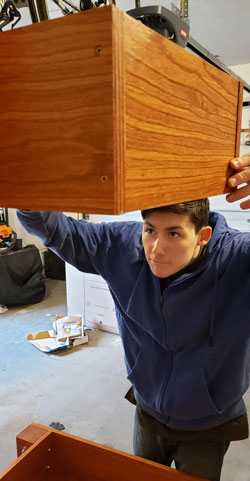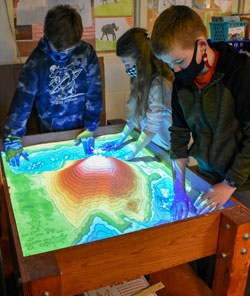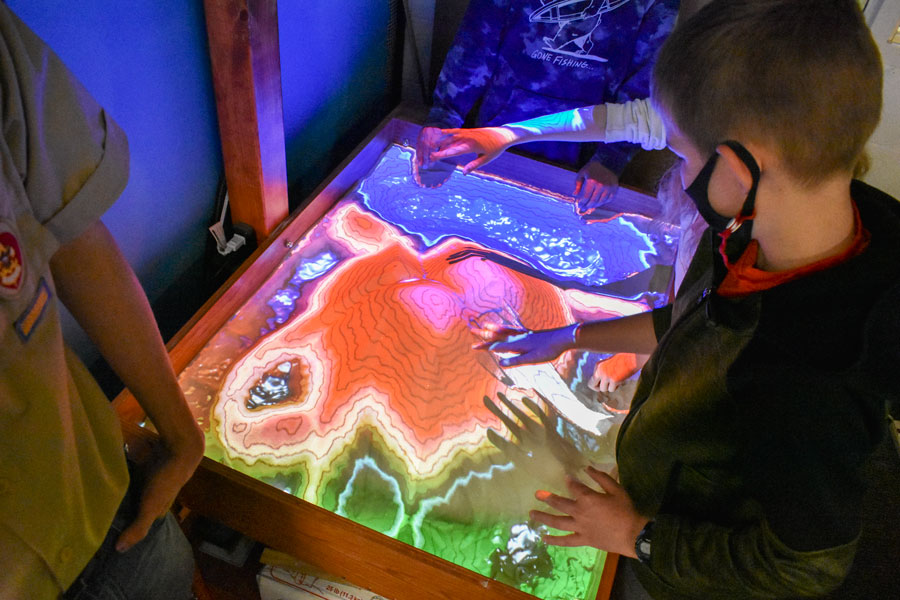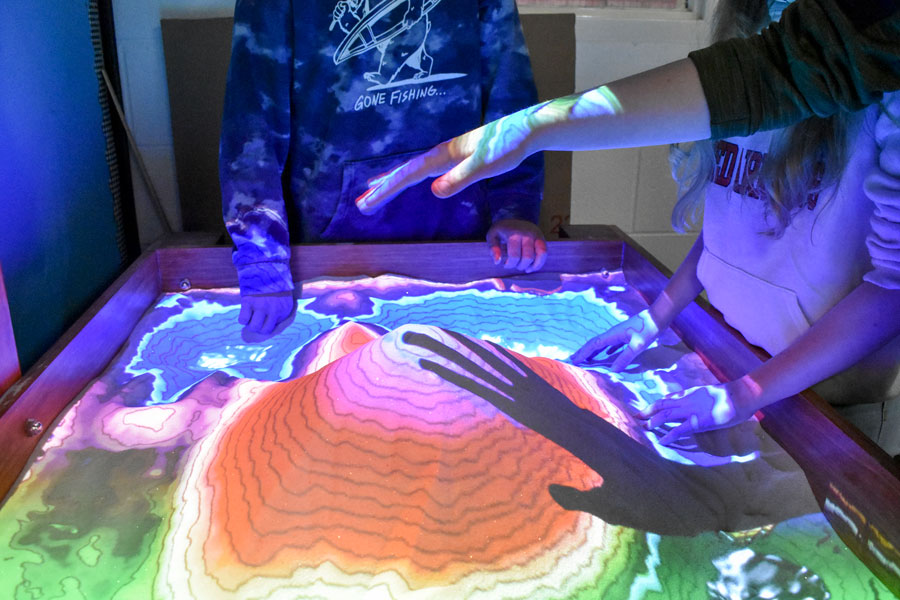Lowell — Have you ever wanted to make it rain with just a wave of your fingers? Carve a river into an empty field and then make it flood? Topple a mountain with your bare hands and see what happens to the surrounding landscape?
At the augmented reality (AR) sandbox in Jennifer Bolhuis’ fourth-grade classroom, students wield all this power and more. The sandbox is an Eagle Scout project and gift from one of Bolhuis’ former students, Lowell High School sophomore David Johnston.

“When I went through fourth grade, Mrs. Bolhuis was the person who got me interested in science,” said David about why he chose this particular project and recipient to be part of his Eagle Scout journey. “That’s, like, the whole reason why I want to (work in) sustainable agriculture. Her class got me into science and erosion and everything. So I wanted to help give back, to show other students that they could also go that way if they were interested.”
David recently finished the sandbox and hand-delivered it to Bolhuis’ classroom at Alto Elementary, where the fourth-graders had been counting down the days until it arrived. This learning tool will help students learn about things like waterways, erosion, topography, glacial movements and other land concepts for years to come.
The augmented reality sandbox starts with a sturdy wooden box filled with exactly three inches of pure white sand. The tool uses a motion sensor, specialized computer software and projector mounted above the box to map the lines of elevation onto the sand, based on its depth in the box. These contoured lines and map elevation colors adjust to the elevation levels of the sand in real time, as students push the sand up to build mountains or dig out pools and rivers.
Students can also make it “rain” over the landscapes they construct by raising their hands above the sand and wiggling their fingers. This feature demonstrates the different ways that water can flow around land formations.
“It’s so much fun to just move the sand around; you don’t even think you’re changing (the landscape) a lot but with the colors changing you can see that you are,” said fourth-grader Everley Postema. “It’s cool because you can cause erosion in the sand and you can see how mountains can get pushed up from the ground, and also how floods form — when it rains you see how the water rises.
“One of the best things about it is that we got to meet (David) and he put so much effort into it to help us learn, and I think that’s really great.”
Real-life Relevance
When David first approached Bolhuis with his idea, the teacher said she was “mind-blown, and just so honored” that her work years ago would inspire such a gift.
“To make something like (an AR sandbox) is a huge feat — who would ever come up with that as a 15-year old?” she said. “I am so proud, and I have such an overwhelming sense of gratitude to David, because this is just an incredible tool to have in our classroom.”
The sandbox offers learning opportunities that fit into the fourth-grade curriculum in myriad ways, Bolhuis said.

“Living in the state of Michigan, with our land being formed by glaciers, this just lends itself to that teaching so well,” she said. “We talk about how glaciers form things like kettle lakes and drumlins, and now we can manipulate those landforms right here, with this visual tool.”
The sandbox AR software also includes programs that allow the user to demonstrate both flood and drought conditions based on the push of a button. This tool has real-life relevance for students in Lowell, where both the Flat River and the Grand River often flood low-lying areas.
One of David’s strongest memories from fourth grade is the annual field trip to the Ludington area, where students get to tour the lighthouse, walk along the foredunes and back dunes and learn how wind moves and shapes the land over time. Thanks to the ongoing pandemic, Bolhuis hasn’t been able to take students on this trip in the past couple years. However, David’s AR sandbox can fill some of that experience gap for the time being, allowing students to manipulate the sand right there in the classroom.
“I didn’t think I’d ever be able to teach something, because I’m just a sophomore!” said David. “I think it’s really cool that kids are actually learning from something that I was able to build.
“I hope they just want to learn more, because Mrs. Bolhuis’ class is really where I said, ‘Hey, I like science.’ School was pretty hard for me – it still is – so being able to give them the opportunity to say, ‘I actually like learning,’ well, that’s great to hear.”
‘One Huge Accomplishment’
As a member of Michigan Crossroads Council, Lowell Troop 102, David credits his time in the Boy Scouts with helping develop his confidence. He first started Scouting as a Tiger Cub, meeting in the Alto Elementary cafeteria, and has now been working on this Eagle Scout project for more than a year. Although he pitched the sandbox project to scout leaders as a freshman, COVID-19 put the project on hold for an entire year.
“This project has been quite a ride, especially trying to do it through a pandemic,” he said. “But I would do it again. I love Scouts – it’s probably why I’m able to get up in front of people and talk.”
That David stuck with the project through all the delays speaks to the qualities Bolhuis saw in him as a fourth-grader, she said.
“He was always a very hard worker, very driven, and to see that blossom into the dedication that comes with achieving Eagle Scout status is very exciting,” she said. “I don’t usually get to see something like this.
“For David to come back and share this with me now, to give this gift to me and my students, is just a really special moment that I will treasure forever. And this is one huge accomplishment of many that are yet to unfold in his future, I just know it.”














